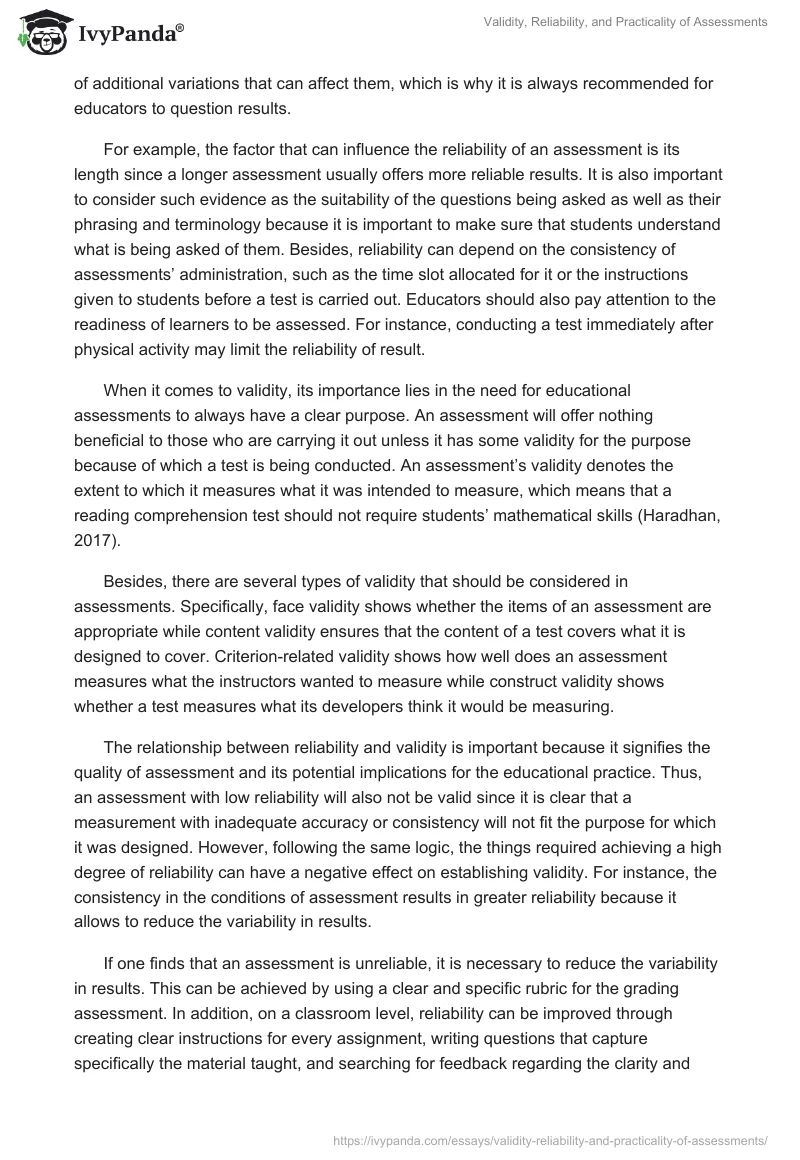Discovering whether an assessment in teaching is effective is concerned with answering several questions. The first is about determining whether an assessment, in the form of testing or other forms, could be applied within the appropriate administrative limitations. The second is whether the assessment measures what educators are intending to measure and the third is whether the results of assessments, such as test scores, carried out by different educators give similar results. If the answer to all of the mentioned questions is positive, then an assessment can be considered reliable, practical, and valid.
The three terms can be often confused between each other because all of them denote the quality of assessments, thus showing if they are effective at measuring the accomplishment of students. However, understanding the differences is important for being able to identify any shortcomings of assessments and make changes to avoid their occurrence. Reliability of an assessment denotes that same results for the same groups of students will be attained (Kadir, Zaim, & Refnaldi, 2018).
A test’s validity identifies the degree to which the chosen method of assessment measures what it states to measure. For example, when assessing writing skills, it is unfair to instruct learners answer a question in which they do not have background knowledge. Finally, assessment practicality implies that a test has been easy to design, implement, and score. Impractical tests, however, may present some challenges to both students and educators, they can be too long, require several examiners to conduct and score, or are generally unnecessarily expensive.
When an assessment’s results are reliable, educators can be confident that conducting repeated or equivalents measurements of learning will give consistent results the recurring assessments. Reliability, therefore, allows making generalized statements regarding students’ achievement levels, which is especially important when the results of assessments are used for decision-making about learning and teaching, or when educators report back to their managers or students’ parents. However, it is important to note that no assessment results can be entirely reliable due to the influence of additional variations that can affect them, which is why it is always recommended for educators to question results.
For example, the factor that can influence the reliability of an assessment is its length since a longer assessment usually offers more reliable results. It is also important to consider such evidence as the suitability of the questions being asked as well as their phrasing and terminology because it is important to make sure that students understand what is being asked of them. Besides, reliability can depend on the consistency of assessments’ administration, such as the time slot allocated for it or the instructions given to students before a test is carried out. Educators should also pay attention to the readiness of learners to be assessed. For instance, conducting a test immediately after physical activity may limit the reliability of result.
When it comes to validity, its importance lies in the need for educational assessments to always have a clear purpose. An assessment will offer nothing beneficial to those who are carrying it out unless it has some validity for the purpose because of which a test is being conducted. An assessment’s validity denotes the extent to which it measures what it was intended to measure, which means that a reading comprehension test should not require students’ mathematical skills (Haradhan, 2017).
Besides, there are several types of validity that should be considered in assessments. Specifically, face validity shows whether the items of an assessment are appropriate while content validity ensures that the content of a test covers what it is designed to cover. Criterion-related validity shows how well does an assessment measures what the instructors wanted to measure while construct validity shows whether a test measures what its developers think it would be measuring.
The relationship between reliability and validity is important because it signifies the quality of assessment and its potential implications for the educational practice. Thus, an assessment with low reliability will also not be valid since it is clear that a measurement with inadequate accuracy or consistency will not fit the purpose for which it was designed. However, following the same logic, the things required achieving a high degree of reliability can have a negative effect on establishing validity. For instance, the consistency in the conditions of assessment results in greater reliability because it allows to reduce the variability in results.
If one finds that an assessment is unreliable, it is necessary to reduce the variability in results. This can be achieved by using a clear and specific rubric for the grading assessment. In addition, on a classroom level, reliability can be improved through creating clear instructions for every assignment, writing questions that capture specifically the material taught, and searching for feedback regarding the clarity and thoroughness of the assessment from colleagues and students. To solve the issue of the lack of validity, it may be useful to conduct a pool with experts or implement a job task analysis. Finally, to make sure that a test is practical, it is necessary to develop a scoring system on how to report the details of an assessment such as materials, duration, and technical issues.
References
Haradhan, M. (2017). Two criteria for good measurements in research: Validity and reliability. Annals of Spiru Haret University, 17(3), 58-82.
Kadir, J., Zaim, M., & Refnaldi. (2018). Developing instruments for evaluating validity, practicality, and effectiveness of the authentic assessment for speaking skill at junior high school. Advances in Social Science, Education and Humanities Research, 276, 98-105.


